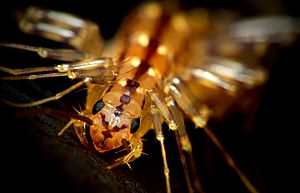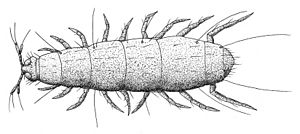Myriapoda facts for kids
Myriapods are a group of arthropods that includes millipedes and centipedes. The name "Myriapoda" means "many legs," and these creatures certainly live up to it! Some myriapods have over 750 legs, like the Illacme plenipes millipede. Others have fewer than ten.
There are about 13,000 known species of myriapods. All of them live on land. Scientists have found fossils of myriapods from the late Silurian period. This means they have been around for a very long time! Some evidence even suggests they might have started to spread out and evolve in the Cambrian period.
Contents
What Are Myriapods Like?
Myriapods have a single pair of antennae on their heads. Most also have simple eyes. Their mouthparts are located on the underside of their head. They have a top lip called an "epistome" and a "labrum." They also have a lower lip made of maxillae. Inside their mouth are strong mandibles for chewing.
Myriapods breathe using tiny holes called spiracles. These holes connect to a system of tubes called a tracheal system. This system is similar to how insects breathe.
Types of Myriapods
Scientists have debated how myriapods are related to other arthropods. There are four main groups of living myriapods. These are Chilopoda (centipedes), Diplopoda (millipedes), Pauropoda, and Symphyla. In total, there are around 12,000 living species in these groups.
Centipedes: Fast Hunters
Centipedes belong to the group Chilopoda. They are known for being fast and fierce predators. Most centipedes hunt at night. They are also venomous, meaning they can inject venom to catch their prey.
There are about 3,300 species of centipedes. They come in many sizes. Some are tiny, like Nannarup hoffmani, which is less than half an inch long. Others are huge, like Scolopendra gigantea, which can be over 12 inches (30 cm) long!
Millipedes: Slow Eaters
Millipedes are part of the group Diplopoda. They look like they have two pairs of legs on most of their body segments. This is because two body segments have fused together. This fusion makes it seem like each segment has twice the usual number of legs.
Millipedes are much slower than centipedes. They usually eat leaf litter and other decaying plant matter. About 8,000 species of millipedes have been described. However, scientists believe there might be many more species yet to be discovered.
One famous millipede, Illacme plenipes, holds the record for the most legs of any animal, with 750! Most millipedes have between 36 and 400 legs. Some millipedes, like Pill millipedes, are shorter and can roll up into a ball for protection, just like pillbugs.
Symphylans: Tiny Soil Dwellers
About 200 species of symphylans are known around the world. They look a bit like small, clear centipedes. Many symphylans live in the soil. Some even live in trees.
When they are young, symphylans have six pairs of legs. As they grow and moult (shed their skin), they add an extra pair of legs each time. Adult symphylans can live for several years and end up with twelve pairs of legs.
Pauropods: Small and Hidden
Pauropoda is another small group of myriapods. They are usually very tiny, only about 0.5 to 2.0 millimeters long. They live in the soil on every continent except Antarctica. Over 700 species have been described.
Scientists think pauropods are closely related to millipedes. Like millipedes, their back plates (called tergites) are fused together across pairs of segments. This is similar to the more complete fusion seen in millipedes.
Arthropleuridea: Ancient Giants
Arthropleuridea were ancient myriapods that are now extinct. The most famous members of this group belong to the genus Arthropleura. These were giant animals that could grow up to 10 feet (3 meters) long! They were likely herbivorous, meaning they ate plants. Scientists believe Arthropleuridea might have been a type of giant millipede.
Images for kids
See also
 In Spanish: Myriapoda para niños
In Spanish: Myriapoda para niños







